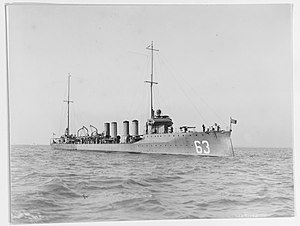Sampson-class destroyer
The Sampson-class destroyers served in the United States Navy during World War I. Commissioned in 1916 and 1917, the class was a modification of the O'Brien and Tucker classes, with the number of 21-inch (533 mm) torpedo tubes increased from four twin-mounts to four triple-mounts. The Sampsons were the final six ships of the 26 "thousand tonner" destroyers. They were the largest and most heavily armed of the "thousand tonners", and the subsequent "flush deck" classes differed mainly in hull design and the engineering plant.
 USS Sampson | |
| Class overview | |
|---|---|
| Name: | Sampson class |
| Operators: | |
| Preceded by: | Tucker class |
| Succeeded by: | Caldwell class |
| Built: | 1915–17 |
| In commission: | 1916–46 |
| Completed: | 6 |
| Retired: | 6 |
| Preserved: | 0 |
| General characteristics | |
| Type: | Destroyer |
| Displacement: |
|
| Length: | 315 ft 3 in (96.09 m) |
| Beam: | 30 ft 7 in (9.32 m) |
| Draft: | 10 ft 9 in (3.28 m) |
| Propulsion: |
|
| Speed: | 29.5 kn (54.6 km/h; 33.9 mph) |
| Complement: | 99 officers and crew |
| Armament: |
|
Design
Armament
While the gun armament was typical for destroyers of this period, the torpedo armament of twelve 21 inch (533 mm) torpedo tubes was a significant increase over the preceding Tucker class, replacing four twin mounts with four triple mounts. Both the gun and torpedo armament would remain standard through the mass-production "flush-deck" Wickes and Clemson classes commissioned through 1921. As with the other "thousand tonners", a factor in the size of the torpedo armament was the General Board's decision to use broadside rather than centerline torpedo tubes.[1] This was due to the desire to have some torpedoes remaining after firing a broadside, and problems experienced with centerline mounts on previous classes with torpedoes striking the gunwales of the firing ship.[2] The Mark 8 torpedo was equipped.
This was the first US destroyer class to mount anti-aircraft guns: two 1 pounder (37 mm) autocannons. Anti-submarine (ASW) armament was added during World War I. Typically, a single depth charge track was provided aft, along with a Y-gun depth charge projector.[3]
Service
The Sampson class served in World War I as convoy escorts in the Atlantic. Wilkes and Shaw served in the United States Coast Guard as part of the Rum Patrol 1926-34. While the other ships of the Sampson class were retired and scrapped 1934-36 to comply with the London Naval Treaty, Allen survived into the 1940s and served through World War II before being decommissioned and scrapped, the only pre-flush-deck destroyer to serve in that war.[5]
Ships in class
The six ships of the Sampson class were:
| Name | Hull no. | Shipyard | Laid down | Launched | Commissioned | Decommissioned | Fate |
|---|---|---|---|---|---|---|---|
| Sampson | DD-63 | Fore River Shipbuilding | 15 April 1915 | 4 March 1916 | 27 June 1916 | 15 June 1921 | Scrapped 1936 |
| Rowan | DD-64 | Fore River Shipbuilding | 10 May 1915 | 23 March 1916 | 22 August 1916 | 19 June 1922 | Scrapped 1939 |
| Davis | DD-65 | Bath Iron Works | 7 May 1915 | 15 August 1916 | 5 October 1916 | 20 June 1922 | USCG 1926-33, scrapped 1934 |
| Allen | DD-66 | Bath Iron Works | 10 May 1915 | 5 December 1916 | 24 January 1917 | 15 October 1945 | Scrapped 1946 |
| Wilkes | DD-67 | William Cramp & Sons | 11 March 1915 | 18 May 1916 | 10 November 1916 | 5 June 1922 | USCG 1926-34, scrapped 1934 |
| Shaw | DD-68 | Mare Island Navy Yard | 7 February 1916 | 9 December 1916 | 9 April 1917 | 21 June 1922 | USCG 1926-33, name removed 1 November 1933 for new ship, scrapped 1934 |
References
Citations
- Friedman, p. 24,34
- Friedman, p. 24
- Friedman, p. 45
- Gardiner, p. 123
- DestroyerHistory.org Sampson Class page
Sources
- Friedman, Norman (2004). US Destroyers: An Illustrated Design History (Revised Edition). Annapolis: Naval Institute Press. ISBN 1-55750-442-3.
- Jane's Fighting Ships of World War I. London: Random House Group, Ltd. 2001. p. 147. ISBN 1-85170-378-0.
- Silverstone, Paul H., U.S. Warships of World War I (Ian Allan, 1970), ISBN 0-71100-095-6.
- Silverstone, Paul H., U.S. Warships of World War II (Ian Allan, 1965), ISBN 0-87021-773-9.
- Gardiner, Robert, Conway's All the World's Fighting Ships 1906-1921, London: Conway Maritime Press, 1985. ISBN 0-85177-245-5.
- Gardiner, Robert and Chesneau, Roger, Conway's All the World's Fighting Ships 1922-1946, London: Conway Maritime Press, 1980. ISBN 0-83170-303-2.
- This article incorporates text from the public domain Dictionary of American Naval Fighting Ships.
External links
| Wikimedia Commons has media related to Sampson class destroyers. |
- Tin Can Sailors @ Destroyers.org - Sampson class
- USS Rowan Reunion Association
- DestroyerHistory.org Thousand Tonner page
- DestroyerHistory.org Sampson Class page
- NavSource Destroyer Photo Index Page
- DiGiulian, Tony Navweaps.com 4"/50 Mks 7, 8, 9, and 10
- DiGiulian, Tony Navweaps.com Pre-WWII US Torpedoes
- US Navy Torpedo History, part 2